The exciting history of Gdansk, an idyllic town at Motlawa River, goes back about 1000 years. Today Gdansk offers a lot of places of interest.
In World War II Gdansk was destroyed almost completely by Soviet forces, but nearly all buildings were reconstructed from historic models.
The Tourist card of Tricity gives you entry to 22 museums and you get discounts at over 250 partners. Besides, you get unlimited access to the public transport. That card is available at the Tourist Information, ul. Długi Targ 28/29, at the main station or at the airport.
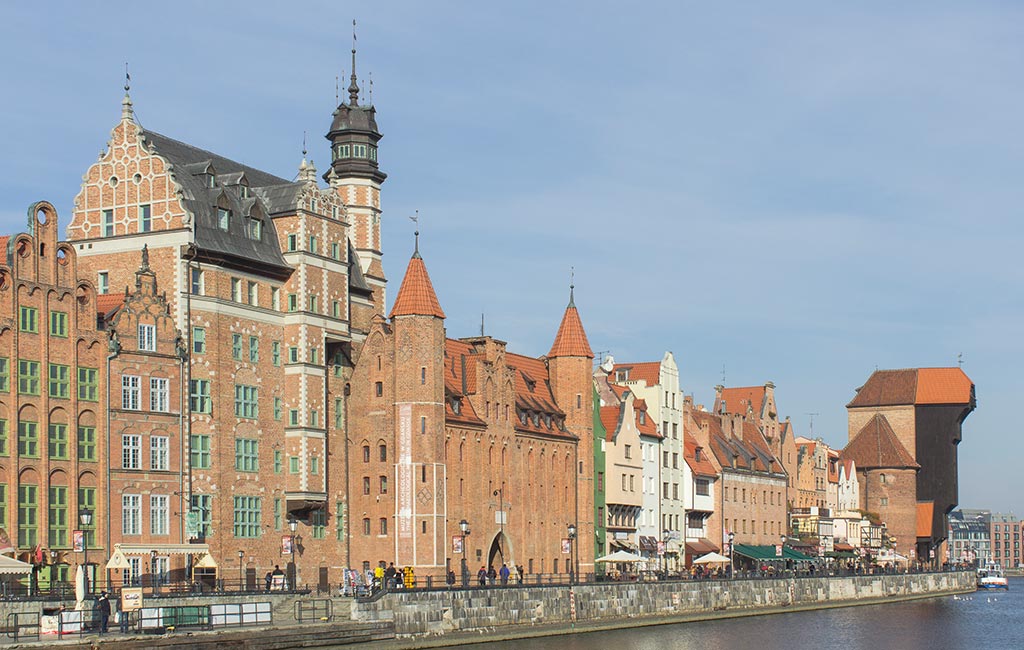
The historic Old Town
Almost all places of interest are located in the historic old town (Glowne Miasto) within a few 100 metres, so the walks are very diverting.
The main streets, the Long Street, as well as Long Market, accommodate the most of the interesting buildings.
The Green Gate
Between the Southern end of Long Market and the waterfront you walk through the so-called Green Gate, which actually isn’t green anymore… But at time of construction, it was built up of green sandstone and owes its name to this fact.
The gate was built in 1571 by Hans Kramer an architect from Dresden, Germany. It was built in Flemish Mannerism Style which is very rare in Eastern Europe. The gate looks like a castle and should have served as a city residence for Polish kings, but it was never used by them. Instead, the former president Lech Wałęsa set up his office with harbour view here.
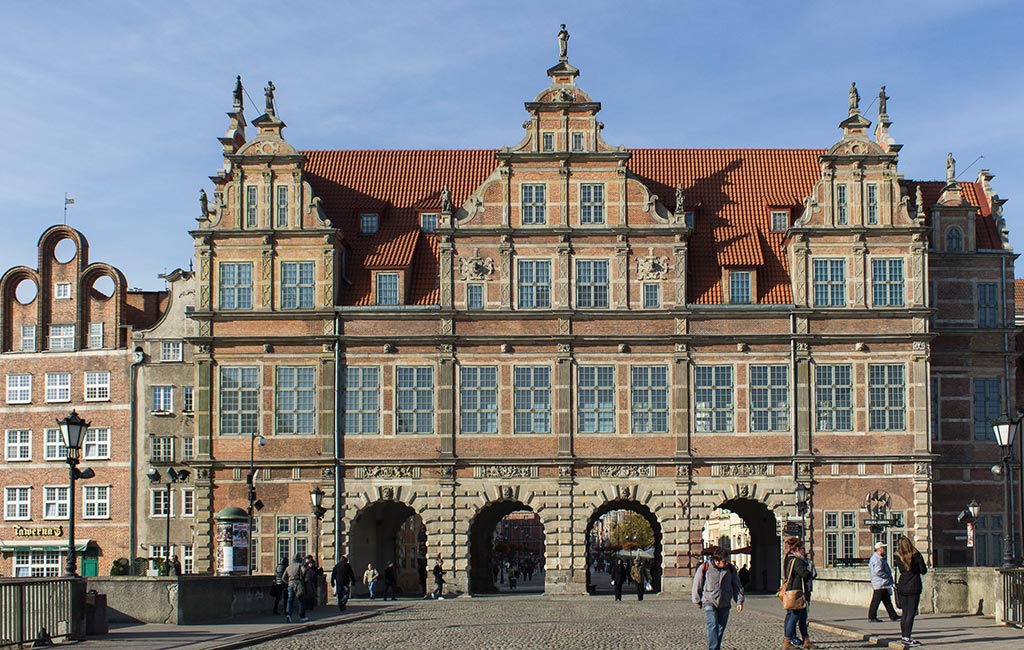
The Long Market (Dlugi Targ)
In most cities the market place is a square, but in Gdansk it more looks like a promenade, with towering, richly decorated private town-houses on both sides. Formerly, the rich citizens and merchants of the Free Hanseatic City of Gdansk lived here. At the Northern end of the street you find two of the most beautiful houses of the street, the Artus Court with Neptune Fountain and the Town Hall.
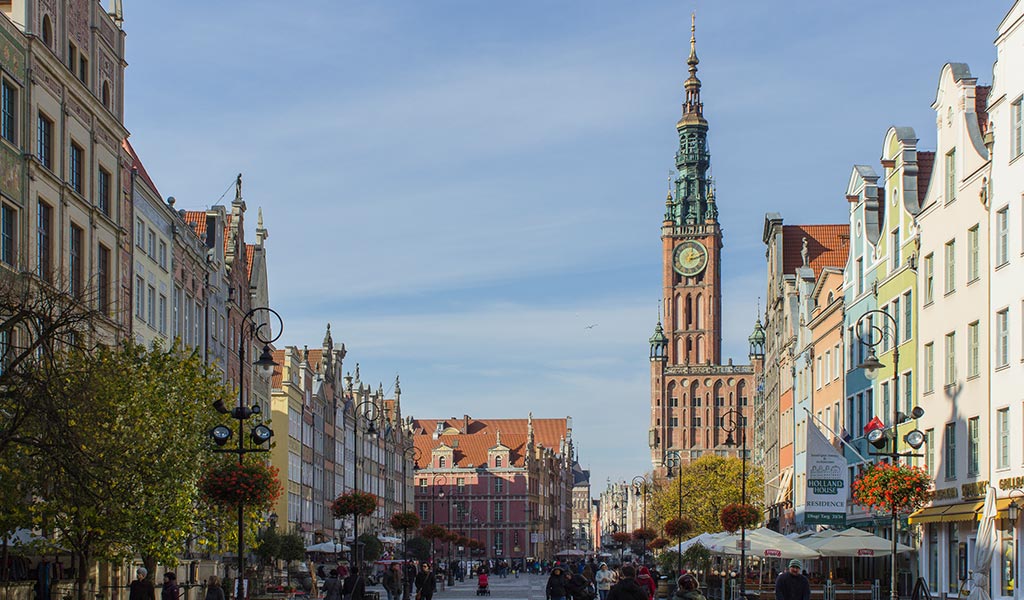
The Golden House
… also called Speymann House or Steffens House, is located not far from the Artus Court.
Its builder-owner was Johannes Speymann, mayor of Gdansk and merchant.
Thanks to its sculptures decorated with gold foil and the luxurious ornaments the house is one of the most famous buildings in Gdansk old town, and maybe also one of the most beautiful.
Artus Court and Neptune Fountain
Already in 1342 the court was first mentioned.
At first, it served as meeting point for rich aristocrats and merchants. Until today a beer counter reminds to this gatherings.
The building burnt down in 1476 and the court was rebuilt in late gothic style. Rebuilding actions in renaissance style followed and later an attic, as well as the sculptures next to the windows, which symbolises the virtues of the citizenry, turned up.
The centrepiece of the court is, without doubts, the Great hall, which is said to be the most beautiful in Gdansk. Here Günther Grass was awarded honorary citizen of Gdansk.
Furthermore, the pompous interior of the court is worth seeing. Next to some renaissance paintings and late gothic sculptures, the 12 metres high renaissance tiled stove, with its 520 coloured tiles, from 1546 is awesome and you shouldn’t miss Anton Möller’s „Last Judgement“.
Besides, you gain insight into the life and history of previous centuries.
The Neptune Fountain was built in 1633 in front of Artus Court by mayor Bartholomäus Schachmann. Under the influence of his journey to Italy he decided to decorate Gdansk with a monument dedicated to Neptune, the God of the Sea. The draft of the fountain is penned by Abraham van den Blocke, like the draft of the Golden House.
The Town Hall
The town hall marks the end of Long Market. The first building in this location was built in the 14th century. After a fire in 1556 the original gothic town hall was rebuilt in Mannerism Style.
Today the Historical Museum of Gdansk is located in the former Town Hall.
Absolutely worth seeing is the Red Hall with is 25 awesome ceiling frescos of Isaak van den Blocke, which are cased in beautiful carvings, as well as the fireplace with the city coat of arms.
The tower offers a fantastic view over the city.
The Long Street (Ul. Dluga)
The Long Street is the extension of Long Market. Together Long Market and Long Street built the former Royal Route – from here the king walked through the old Gdansk to the Main Hall.
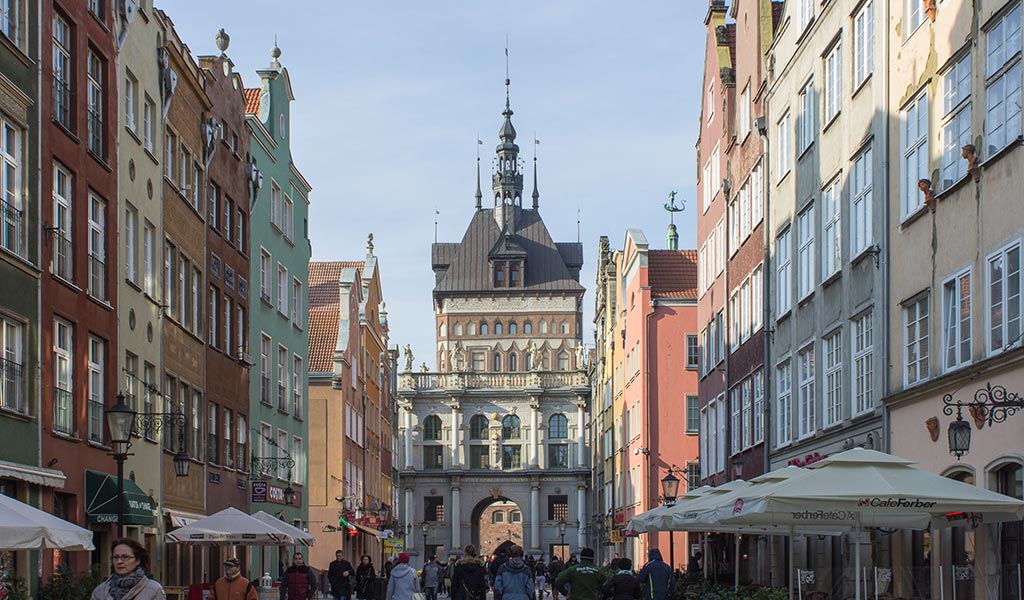
Uphagen House
The Uphagen House at Long Street 20 is one the few town-houses from 18th century, which is open for visitors. It is one of the most important historical buildings of Gdansk.
The Gdansk merchant Johan Uphagen had bought the estate in 1775 and built a town-house there, which was family property until 1910. In 1911 the house was converted to a museum of civic home decor.
The Amber Museum
The resin from the Baltic Sea is closely connected to the „golden“ city, so this museum is an absolute must-see.
Once, the torture chamber, the pillory and the city jail were located in the historic complex of buildings. Today you can discover the evolutionary history, the collection, the trade routes and the artful manufacture of amber on 5 floors.
Modern architecture, multimedia element and modern installations make this exhibition absolutely well worth seeing.
Furthermore, the exhibition is dedicated to the history of the building. In the brick red gothic tower, which is connected with the torment chamber you can still see leg and neck irons, handcuffs, as well as instruments of torture in the cells.
Mariacka Street
Mariacka Street is situated between St. Mary’s and the promenade, perhaps one of the most beautiful streets of Gdansk.
In the small, richly decorated private town-houses, with its famous elevated terraces, you find a lot of bars and cafés, which invite to stay.
In the cellars of the houses a lot of small galleries, craft shops and amber shops are located. If you want to take home a souvenir made of amber, you are absolutely right in this street.
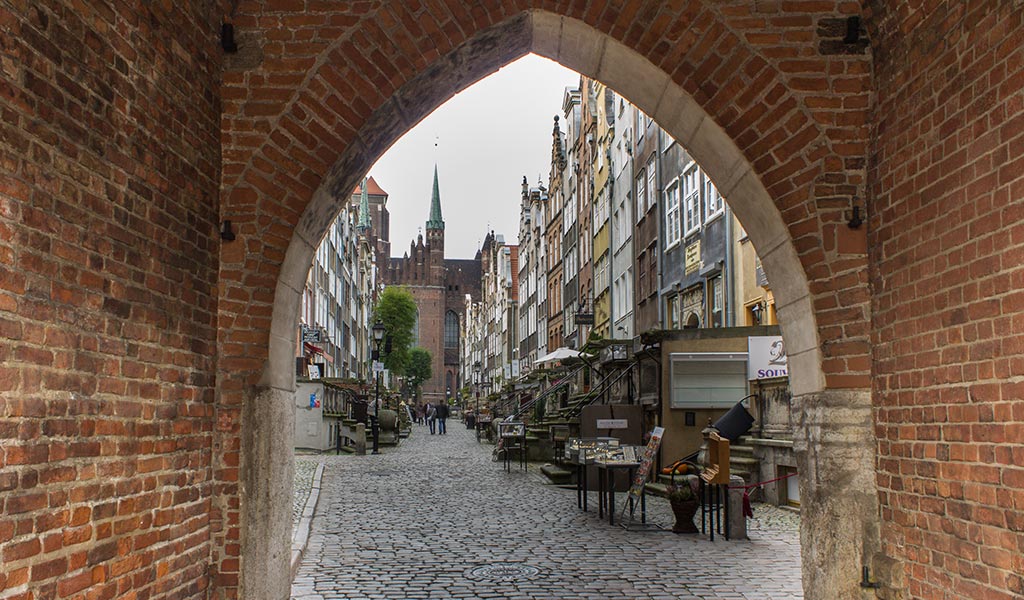
The Market Hall
The building in Neo-Gothic Style was built in 1896 on the site of a Dominican monastery.That is why the locals still call it Dominic hall today, even if there is nothing left of the old monastery than the St. Nicholas’ Church opposite the market hall.
Here, offside the tourist ways you can buy fresh products at cheap prices and observe the locals shopping.
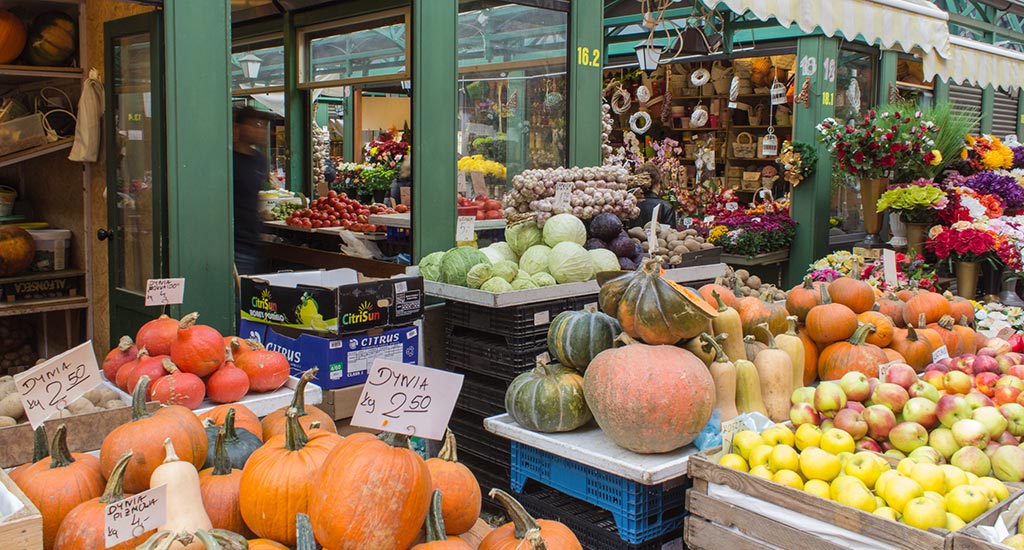
St. Mary’s Church (Bazylika Mariacka)
Behind the town hall St. Mary’s rises like built for eternity.
With 105 metres length and 66 metres width it is one of world’s biggest brick churches. Inside the three-naved hall church, with its filigree net and stellar vaults and its 37 huge windows, there is room for about 25.000 people. Big parts of the precious interior decorations were lost in World War II. 500 tomb slabs, the three-bladed high altar and the copy of the world-famous drawing: „The Last Judgement“ of Hans Memling (the original is in the National Museum) were preserved.
One of the church’s biggest attractions is the 12 metres high astronomic clock from 1470, which sets in motions its figures play daily at 12 o’clock.
In no case you should miss a visit of the tower, which is 80 metres high, and the view over Gdansk is fantastic. However, you need endurance and you should be free from giddiness to clim up the 400 steps to the top.
The Royal Chapel (Kaplica Królewska)
St. Mary’s, the main church of Gdansk, had been devolved to the protestants and was reserved for them, because of the reformation.
The Catholic church had no more house of prayer in Gdansk now, because of that the Polish King John III. Sobieski donated a bigger sum of money to built a new chapel. Finally, in 1681 the Royal Chapel was completed at premises next to St. Mary’s.
Presumably, the drafts of the Royal Chapel come from the royal architect Tylman van Gamere.
The Crane
In 1444 the building received todays form. It was built in style of brick Gothic and still is one of the oldest lifting devices of this kind.
The gate is made of two towers, which are connected by a wooden device with pulley block. It served as granary, loading of goods and town gate.
In World War II the Crane was destroyed completely — the wooden device burnt down and just a part of the masonry preserved.
In the 50th the gate was reconstructed according to plans of Stanisław Bobiński. It was given to the National Maritime Museum of Gdansk, which is part of the Central Maritime Museum.
There are exhibitions about the history of Gdansk harbour and you can visit the crane mechanism.
Today the Gate is the town’s landmark and the most taken picture of Gdansk.
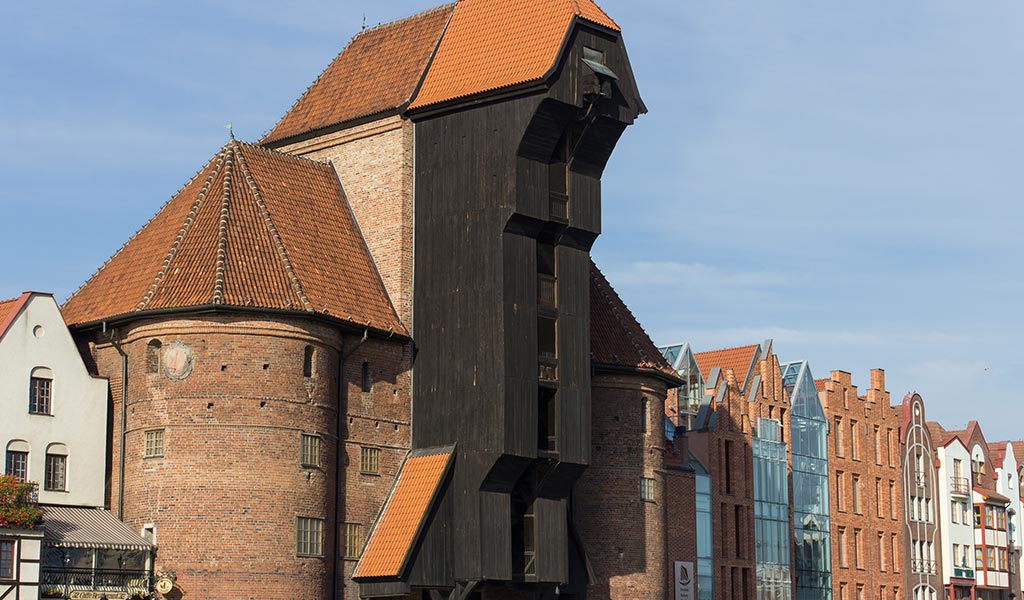
The Grand Armoury
The Grand Armoury is a fantastic example of Dutch Mannerism architecture in Gdansk and one of the most valuable representations of this style in Europe.
It was finished in 1609 according to the design of the Flemish architect Anton van Obberghen.
The turrets, conks and the two front gates decorated with the city arms, as well as the bronze sculptures are typical for the Dutch Mannerism.
Once the Grand Armoury was built to store stuff, mainly weapons and ammunition.
Today the former armoury is used by the Gdansk Academy of Fine Arts.
Other Places of interest in Gdansk
The Great Mill
The mill, located on Radunia Isle in Gdansk Old Town, was built in the 14th century by Teutonic Knights, who also built the Radunia canal.
The water of the canal powered 18 huge wheels until 1945. It was considered to be the largest industrial plant in Europe during the Middle Ages.
Today a huge shopping mall is located in the mill.
St Catherine’s Church
St Catherine’s Church, vis-à-vis the mill, is the oldest church of Gdansk. The brick building was built in 1227, however it has been increased and altered over the centuries.
In the inside you find a gorgeous painting, the triptych of Anton Moeller, „the painter of Gdansk“, as well as paintings of Jakob Schmidt and Izaak van den Blocke.
Furthermore, the tomb of the astronomer Johannes Hevelius can be found here.
The former Lenin Shipyard (Stocznia Gdańska)
North of the idyllic old town, suddenly rusty cranes rise up to the sky.
In summer 1980 here on the former Lenin Shipyard history was made. Back then, the employees went on strike — this was the hour of birth of Solidarność.
Shortly the strike became a critical of the regime mass movement, which united millions of Poles. Their leader: Lech Wałęsa. After seesaw Solidarność was accepted as first free union in the Eastern Bloc – the fall of the communism couldn’t be delayed anymore.
In 1990 the first democratic voted president of Poland was called Lech Wałęsa.
Three huge crosses on Solidarność Square, in front of the shipyard, remind to the killed shipyard workers, who spoke out against the regime.
In a bunker next to the shipyard there is an exhibition called „Roads to Freedom“, which delivers an insight into the events of 1980.
The shipyard is accessible for interested persons, although it still is in operating state. Parts of the Shipyard were also discovered by local artists, who established their studios here.
Oliva Park with Cathedral and Abbot’s Palace
Oliva is one of the most beautiful quarters of Gdansk. The quarter belonged to the Order of Cistercians for centuries. They built a park with an English Garden, a tropical centre, ponds and beautiful alleys here, as well as the Gdansk Botanical Garden, a church, the monastery and the abbot’s residence.
The Abbot’s Palace was built in 1756 by the last Polish abbot of the Cistercian abbey. Today the department of contemporary art of Gdansk National Museum resides in the palace.
The highlight of Oliva probably is Oliva Cathedral, with its three-nave basilica with transept and a polygonal chancel with choir ambulatory. It is the longest Cistercian church of the world and the interior design is absolutely amazing. The huge pipe is really awesome, the organ front is an important work of baroque wood craft and it is one of the hugest organ fronts of the world.
Listen to a pipe concert, you won’t be sorry!
The Central Maritime Museum Gdansk
The Crane with its exhibition about the history of Polish Navy and the life in the Medieval seaport belongs to the Central Maritime Museum Gdansk.
Also the three historic renaissance granaries on Olowianka Island, on the other side of Motlawa River, belong to the museum. Among other things, you can view the load of a Swedish caravel, which sunk in 1627. Furthermore, the granaries inform about the Polish seafaring with ship and harbour models, and you can see uniforms and old Swedish cannons from Swedish-Polish wars.
Alongside the isle the cargo ship „Sołdek“ is tied up. It is the first cargo ship built in Gdansk after World War II, used to transport ore and coal. The „Sołdek“ also belongs to the museum today and can be visited.
The Westerplatte
On the Westerplatte history was made.
On September 1, 1939, the Polish ammunition dump, which was built on the Peninsula in the Vistula entry, was pounded by the German Ship „Schleswig-Holstein“ — this was the beginning of World War II.
1.500 German soldiers attacked the 182 Polish soldiers, positioned on the Westerplatte, with heavy ordnance and airplanes. This was not an easy task, as they thought it would be. The Polish defenders offered grim resistance for 7 days, until they surrendered.
Today the destroyed barracks, the bunker and a small exhibition in an old guard house are evidence for the combats. Since 1966 the Westerplatte Monument commemorates the battle of 1939. For the Pole Westerplatte still is the symbol of resistance against Nazi Germany.
 English
English
 English
English  Deutsch
Deutsch  Polski
Polski 
